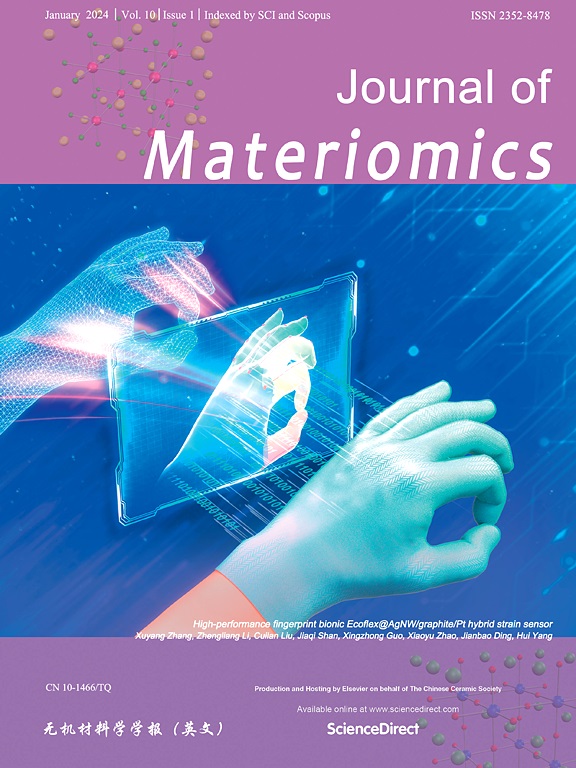SnO2-SnS2 /石墨烯异质结复合材料促进了高性能钠离子存储
IF 8.4
1区 材料科学
Q1 CHEMISTRY, PHYSICAL
引用次数: 0
摘要
电极材料纳米结构的设计包括减小材料尺寸和设计合适的异质结构,在改善电荷存储动力学和提高实用性能方面具有很大的潜力。在这项研究中,我们提出了通过控制硫化反应过程合成SnO2-SnS2/石墨烯异质结复合材料的创新方法。独特的结构使该复合材料具有高电子导电性、离子扩散速度快、电化学活性高、结构稳定性好、反应位点丰富等特点,是一种高效的钠离子电池负极材料。半电池测试表明,SnO2-SnS2 / r-G复合材料在5 a /g的高电流密度下,第一库仑效率达到77.3%,具有显著的循环稳定性。值得注意的是,该复合材料在1000次循环后仍保持330 mA·h/g的可逆容量,容量保持率为77.5%。此外,我们通过原位和非原位表征方法阐明了异质结复合电极的特定钠储存机制。此外,以Na0.53MnO2为阴极,SnO2-SnS2 / r-G复合材料为阳极的全电池具有出色的倍率性能和长期循环稳定性。这种异质结构设计和制造方法,加上优异的性能指标,表明SnO2-SnS2 / r-G异质结构是sib应用中先进阳极材料的有希望的候选材料。本文章由计算机程序翻译,如有差异,请以英文原文为准。


SnO2SnS2/graphene heterojunction composite promotes high-performance sodium ion storage
The design of electrode material nanostructures including reducing material sizes and designing appropriate heterostructures, has great potential in improving charge storage dynamics and enhancing practical performance. In this study, we present the innovative synthesis of SnO2![]() SnS2/graphene heterojunction composite materials via a controlled vulcanization reaction process. The unique structure endows the composite with high electronic conductivity, rapid ion diffusion rates, elevated electrochemical activity, excellent structural stability, and abundant reaction sites, making it a highly efficient anode material for sodium-ion batteries (SIBs). Half-cell tests demonstrate that the SnO2
SnS2/graphene heterojunction composite materials via a controlled vulcanization reaction process. The unique structure endows the composite with high electronic conductivity, rapid ion diffusion rates, elevated electrochemical activity, excellent structural stability, and abundant reaction sites, making it a highly efficient anode material for sodium-ion batteries (SIBs). Half-cell tests demonstrate that the SnO2![]() SnS2/r–G composite achieves a first Coulombic efficiency of 77.3% at a high current density of 5 A/g, showing remarkable cycling stability. Remarkably, the composite retains a reversible capacity of 330 mA⋅h/g after 1000 cycles, with a capacity retention rate of 77.5%. Moreover, we elucidate the specific sodium storage mechanisms of the heterojunction composite electrode via in-situ and ex-situ characterization methods. Furthermore, a full battery utilizing Na0.53MnO2 as the cathode and SnO2
SnS2/r–G composite achieves a first Coulombic efficiency of 77.3% at a high current density of 5 A/g, showing remarkable cycling stability. Remarkably, the composite retains a reversible capacity of 330 mA⋅h/g after 1000 cycles, with a capacity retention rate of 77.5%. Moreover, we elucidate the specific sodium storage mechanisms of the heterojunction composite electrode via in-situ and ex-situ characterization methods. Furthermore, a full battery utilizing Na0.53MnO2 as the cathode and SnO2![]() SnS2/r–G composite as the anode exhibits outstanding rate performance and long-term cycling stability. This method of heterostructure design and fabrication, coupled with the exceptional performance metrics, suggests that the SnO2
SnS2/r–G composite as the anode exhibits outstanding rate performance and long-term cycling stability. This method of heterostructure design and fabrication, coupled with the exceptional performance metrics, suggests that the SnO2![]() SnS2/r–G heterostructure is a promising candidate for advanced anode materials in SIBs applications.
SnS2/r–G heterostructure is a promising candidate for advanced anode materials in SIBs applications.
求助全文
通过发布文献求助,成功后即可免费获取论文全文。
去求助
来源期刊

Journal of Materiomics
Materials Science-Metals and Alloys
CiteScore
14.30
自引率
6.40%
发文量
331
审稿时长
37 days
期刊介绍:
The Journal of Materiomics is a peer-reviewed open-access journal that aims to serve as a forum for the continuous dissemination of research within the field of materials science. It particularly emphasizes systematic studies on the relationships between composition, processing, structure, property, and performance of advanced materials. The journal is supported by the Chinese Ceramic Society and is indexed in SCIE and Scopus. It is commonly referred to as J Materiomics.
 求助内容:
求助内容: 应助结果提醒方式:
应助结果提醒方式:


